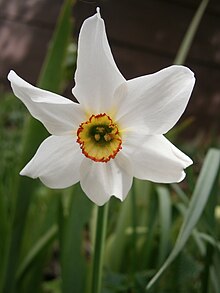Narcissus poeticus
| Poet's daffodil | |
|---|---|
 |
|
| Scientific classification | |
| Kingdom: | Plantae |
| Clade: | Angiosperms |
| Clade: | Monocots |
| Order: | Asparagales |
| Family: | Amaryllidaceae |
| Subfamily: | Amaryllidoideae |
| Genus: | Narcissus |
| Species: | N. poeticus |
| Binomial name | |
|
Narcissus poeticus L. |
|
| Synonyms | |
|
|
Narcissus poeticus (poet's daffodil, poet's narcissus, nargis, pheasant's eye, findern flower, and pinkster lily) was one of the first daffodils to be cultivated, and is frequently identified as the narcissus of ancient times (although Narcissus tazetta and Narcissus jonquilla have also been considered as possibilities). It is also often associated with the Greek legend of Narcissus. It is the type species of the genus Narcissus. Extremely fragrant, with a ring of petals in pure white and a short corona of light yellow with a distinct reddish edge, It grows to 20 to 40 cm (7.9 to 15.7 in) tall, and is widely naturalized in North America.
It is commonly known as 'pheasant's-eye daffodil' or 'poet's narcissus' (in the UK), 'claudinette', 'narcisse', 'narcisse poetes' and 'oeil de faisan' (in France), 'weiße Narzisse' (in German), 'narciso (in Italian and Spanish) and 'narciso blanco' and 'trompón' (in Spanish) and 'pingstlilja' (in Swedish).
It was published and described by Carl Linnaeus in his book Species Plantarum on page289 in 1753.
It was verified by United States Department of Agriculture and the Agricultural Research Service on 9 July 2015.
Narcissus poeticus is native to central and southern Europe from Spain, France through Switzerland, Austria to Croatia, Greece and Ukraine. It is naturalized in Great Britain, Belgium, Germany, the Czech Republic, Azerbaijan, Turkey, New Zealand, British Columbia, Washington State, Oregon, Ontario, Quebec, Newfoundland, and much of the eastern United States from Louisiana and Georgia north to Maine and Wisconsin.
...
Wikipedia
